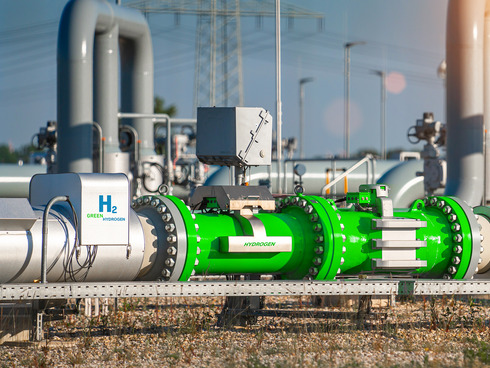#hydrogen gas generator
Text
The Role of Hydrogen Gas Plants in Energy Transition

Introduction
In recent years, the world has witnessed a paradigm shift in its energy landscape, driven by a pressing need to address climate change and reduce our dependence on fossil fuels. Hydrogen gas has emerged as a frontrunner in this transition, playing a pivotal role in the quest for cleaner and more sustainable energy sources. This article will delve into the role of hydrogen gas plants in the energy transition, exploring their significance, applications, and the environmental benefits they bring.
What is Hydrogen Gas?
Before delving into the role of hydrogen gas plants, it’s essential to understand what hydrogen gas is. Hydrogen, the lightest and most abundant element in the universe, is a colorless, odorless gas. It holds the key to a sustainable energy future due to its versatility and environmental friendliness.
The Hydrogen Production Process
Electrolysis: The Green Way
One of the primary methods of producing hydrogen gas is through electrolysis. This process involves splitting water (H2O) into its constituent elements, hydrogen (H2) and oxygen (O2), using electricity. When renewable energy sources like wind or solar power the electrolysis process, the hydrogen produced is green and clean.
Steam Methane Reforming (SMR)
Conventional hydrogen production has long relied on steam methane reforming, which extracts hydrogen from natural gas. While it’s an established method, it’s not as environmentally friendly as electrolysis, as it produces carbon emissions.
Role of Hydrogen Gas in Energy Transition
Hydrogen gas plays a multifaceted role in the energy transition, offering solutions to various challenges.
1. Decarbonizing Transport
The transportation sector is a significant contributor to carbon emissions. Hydrogen fuel cell vehicles offer a clean alternative to traditional gasoline and diesel vehicles. These vehicles convert hydrogen gas into electricity to power the vehicle, emitting only water vapor as a byproduct.
2. Grid Balancing
Renewable energy sources like wind and solar are intermittent. Hydrogen can act as a storage medium, storing excess energy during periods of surplus and releasing it when needed. This helps stabilize the energy grid and ensures a consistent power supply.
3. Industrial Applications
Hydrogen is a vital feedstock for various industrial processes, including ammonia production and oil refining. The use of green hydrogen in these applications reduces the carbon footprint of these industries.
4. Residential Heating
Hydrogen can replace natural gas in residential heating systems, reducing greenhouse gas emissions associated with home heating.
Environmental Benefits
1. Zero Emissions
Green hydrogen, produced through renewable energy-powered electrolysis, is entirely emissions-free. Its use in various sectors can significantly reduce carbon emissions.
2. Air Quality Improvement
Hydrogen fuel cell vehicles contribute to better air quality, as they produce zero tailpipe emissions.
3. Energy Security
Hydrogen diversifies the energy mix, reducing dependence on fossil fuels and enhancing energy security.
Challenges and Future Prospects
The adoption of hydrogen gas faces challenges, including high production costs and the need for infrastructure development. However, ongoing research and investments are expected to drive down costs and expand the hydrogen economy.
(FAQs)
Q 1. How is hydrogen gas produced?
Ans — Hydrogen gas can be produced through methods like electrolysis and steam methane reforming. Electrolysis powered by renewable energy is the greenest and cleanest method.
Q 2. What are the main applications of hydrogen gas?
Ans -Hydrogen gas is used in various applications, including fuel cell vehicles, grid balancing, industrial processes, and residential heating.
Q 3. How does hydrogen contribute to environmental benefits?
Ans -Hydrogen gas, particularly green hydrogen, is emissions-free and can improve air quality. It also enhances energy security by diversifying the energy mix.
Q 4. What are the challenges in adopting hydrogen gas technology?
Ans -Challenges include high production costs and the need for infrastructure development. However, ongoing research and investments are expected to address these issues.
Q5. What is the future outlook for hydrogen gas in the energy transition?
Ans -The future of hydrogen gas is promising, with ongoing efforts to reduce costs and expand its use in various sectors, ultimately contributing to a cleaner and more sustainable energy future.
#hydrogen gas plant#hydrogen gas generator#hydrogen green gas#psa hydrogen gas#psa gas plant#psa hydrogen generator
1 note
·
View note
Video
youtube
600ml 3000ml 4500ml 99.99% high purity molecular hydrogen generator hydr...
#hydrogen generator#hydrogen inhalation machine#hydrogen breathing inhalation machine#hydrogen generator breathing#hydrogen inhalation generator 3000ml#hydrogen inhalation machine breathing#hydrogen oxygen inhaler#browns gas inhaler
2 notes
·
View notes
Text
I've been chipping at a new oni save recently and I have to say I have gotten way less ambitious with my teleporter planet over my past few saves. In a lot of my earlier saves Id dive right in there, but nowadays I find myself ignoring the teleporter for a good while before dipping in to set up some basic utilities there before leaving again and continuing to stall lol
#rat rambles#oni posting#probably because Ive been busy coring out my starting planetoid in my more recent playthroughs#I do want to do some space travel and setting up several colonies but Im not quite sure how Im going to go about it#Ill probably need to use my teleporter planetoid to set up my rocketry program since it has an oil biome but idk#I could in theory go for a steam engine until I get a radbolt engine or a hydrogen engine set up#which honestly Im not sure which I wanna go for since I havent rly played around with either#radbolt would probably be easier to rush but hydrogen would be easier in the long term I think#its all abt the difference between getting a radbolt generation system set up safely vs getting supercoolant#now I usually tend to mostly just stick to petroleum engines but thats because I lack ambition#I could be using that petroleum for power instead#although currently my power situation is actually going pretty ok all things considered#now its a very ducktaped solution given that I am procrastinating on actually properly taming the hydrogen vent Im using for part of it#rn Im using a cool slush vent to produce coolant for the area and using that heat to warm it up enough to be filtered without freezing#but thats a very unstable solution so once I get access to better options Ill likely just fully block it off and call it good#as for my alternative power source Ive recently set up coal generators after getting my obligatory sage hatch farm set up#Im still working on automating it all but itll do it's job just fine for now#I also wanna tap into my cold brine vent soon both for potential extra coolant and for another water source#currently Im fine on water but I wanna get bristle berry farms set up soon so I just wanna be sure Ill have enough#honestly the thing Im saddest abt is that I dont have any natual gas vents#I usually like to get a gas range running quite early so the combination of no natural gas vents and no oil biome is quite saddening#like there are other ways but none that seem particularly worth it to me#anyways Im still sick and exhausted so Im gonna go to bed now#just wanted to make sure everyone knows Im alive
0 notes
Text
Europe Gas Generator Market Growth, Trends, Demand, Industry Share, Challenges, Future Opportunities and Competitive Analysis 2033: SPER Market Research
The Europe Gas Generator Market encompasses the production, distribution, and utilization of gas-powered generators across European countries. With increasing concerns about energy security, environmental sustainability, and power reliability, the demand for gas generators is rising. Key drivers include the transition to cleaner energy sources, infrastructure development, and backup power requirements. Additionally, advancements in gas generator technology, such as improved efficiency and reduced emissions, contribute to market growth. Key players focus on innovation, product differentiation, and service quality to meet the diverse needs of customers and capitalize on market opportunities in Europe.

#Europe Gas Generator Market#Europe Gas Generator Market Challenges#Europe Gas Generator Market Competition#Europe Gas Generator Market Demand#Europe Gas Generator Market Future Outlook#Europe Gas Generator Market Growth#Europe Gas Generator Market Report#Europe Gas Generator Market Revenue#Europe Gas Generator Market Segmentation#Europe Gas Generator Market Share#Europe Gas Generator Market Size#Europe Gas Generator Market Trends#Europe Hydrogen Gas Generator Market#Europe Industrial Gas Generator Market#Europe Laboratory Gas Generators Market#Europe Large Generator Market#Europe Natural Gas Generator Market#Europe Natural Gas Generator Market Forecast#Europe Natural Gas Generator Market Opportunities#Europe Power Generator Market#Europe Residential Gas Generator Market#Gas Generator Market
0 notes
Text
The Global Hydrogen Gas Generation System market would witness a CAGR of around 5.8% during 2022-27, owing to the surging demand for hydrogen gas for chemical processing, fuel cells, refining, petroleum recovery, fertilizers manufacturing, aerospace, etc. The growing focus on reducing greenhouse gas emissions has boosted the demand for hydrogen gas generators across the globe.
#Global Hydrogen Gas Generation System market#Global Hydrogen Gas Generation System market News#Global Hydrogen Gas Generation System market GrowthGlobal Hydrogen Gas Generation System market News#Global Hydrogen Gas Generation System market Report
0 notes
Text
The global Blue Ammonia Market is expected to grow from an estimated USD 78 million in 2023 to USD 7,664 million by 2030, at a CAGR of 62.3% according to a new report by MarketsandMarkets™.
#blue ammonia#hydrogen#hydrogen economy#energy#power#power generation#utilities#renewable energy#renewable#clean energy#clean environment#carbon emission reduction#carbon reduction#reduce co2 emissions#reduce carbon emissions#reduce greenhouse gas emissions
1 note
·
View note
Text
0 notes
Text
0 notes
Video
youtube
OH2000 Oxyhydrogen HHO Gas Generator About Alkaline Water Electrolysis W...
#OH2000 oxyhydrogen generator#hho gas generator#hydrogen welding machine hho generator#okay energy hho generator#380v hho generator
0 notes
Text
The Evolution of Gas Turbines Part 2
The Evolution of Gas Turbines Part 2
Part 1
Gas Turbine Development Trends: Hydrogen Energy
Recent world trends related to the development of clean energy have led to an increased focus on the use of hydrogen as a cleaner fuel for gas turbines and with it, the need to develop gas turbine plants that can operate both on a mixture of hydrogen with natural gas and on pure hydrogen. The use of hydrogen as a fuel can significantly reduce…

View On WordPress
#aerospace & space exploration#analysis#axstream#design#evolution of gas turbines#gas turbine design#gas turbine development#gas turbine software#gas turbines#general – turbomachinery#hydrogen turbines#Industry#optimization#power generation#turbine#turbine design
0 notes
Text
The Global Hydrogen Gas Generation System market would witness a CAGR of around 5.8% during 2022-27, owing to the surging demand for hydrogen gas for chemical processing, fuel cells, refining, petroleum recovery, fertilizers manufacturing, aerospace, etc. The growing focus on reducing greenhouse gas emissions has boosted the demand for hydrogen gas generators across the globe.
#Global Hydrogen Gas Generation System market#Global Hydrogen Gas Generation System market News#Growth#Global Hydrogen Gas Generation System market Report
0 notes